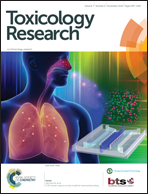The neurotoxicity induced by PM2.5 might be strongly related to changes of the hippocampal tissue structure and neurotransmitter levels
Abstract
Objective: The complex components of PM2.5 including metal elements transported through the blood brain barrier could induce nervous system damage. This study discusses the relationship between rats’ learning and memory and changes in the hippocampal neuron histomorphology and neurotransmitter levels induced by PM2.5 exposure. Methods: Male rats were treated with different concentrations of PM2.5 by tracheal perfusion once per week for up to 12 weeks. After the rats were sacrificed, the main metal element contents (Al, Pb, Cu, Mn, As, Cr, Cd, and Ni) of the blood and whole hippocampus, levels of neurotransmitters released in the whole hippocampus and relative receptors, and changes in the hippocampal structure were detected. Results: The results showed that PM2.5 significantly reduced the cognitive learning abilities of rats. PM2.5 exposure increased the contents of hippocampal lead, manganese, and aluminum. The level of glutamic acid was increased in the hippocampal tissues of the 20 mg kg−1 group, in combination with the decreased N-methyl-D-aspartate glutamate receptor (NMDAR) and increased metabotropic glutamate receptor type1 (mGluR1) expression. Increased clearance, a mild disorder of arrangement, and mild edema could be observed in the rat hippocampal neurons treated with PM2.5. Conclusion: PM2.5-induced defects in learning and memory may be related to the morphological abnormalities of the hippocampus and the abnormal expression of neurotransmitters and their receptors.



 Please wait while we load your content...
Please wait while we load your content...